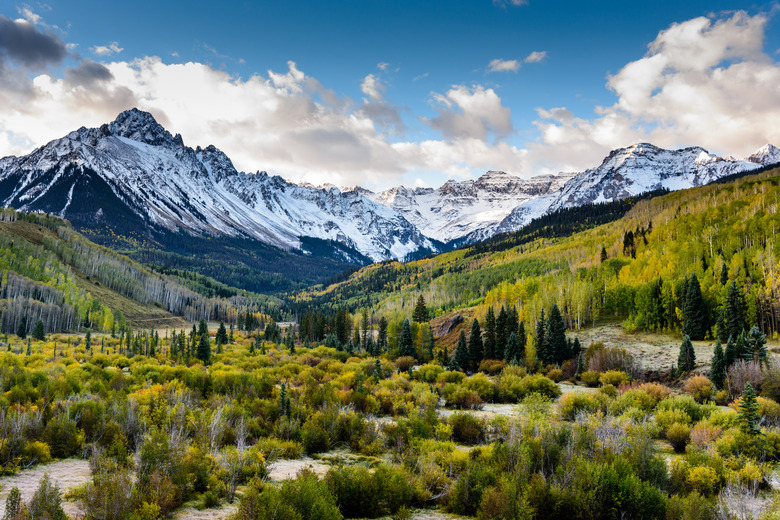Types Of Geography Features At A Plate Boundary
The theory of plate tectonics, formulated in the 1960s, describes how the Earth's crust is fractured into at least a dozen distinct plates. As these plates slowly move about, they interact with each other, forming boundary zones. Each of these different types of plate boundaries produces unique geographical features on the surface, including fault lines, trenches, volcanoes, mountains, ridges and rift valleys.
Fault Lines
Fault Lines
A transform boundary connects two diverging boundaries, creating a fault line. This line represents an area of shear, where two plates are moving horizontally against one another. An example of a fault line is the San Andreas Fault, which connects the East Pacific Rise, to the south, with the South Gorda, Juan de Fuca and Explorer Ridges, to the north.
Trenches
Trenches
Trenches are geological features formed by convergent boundaries. When two tectonic plates converge, the heavier plate is forced downward, creating a subduction zone. This process results in the formation of a trench. The Marianas Trench is an example of a trench formed by the convergence of two oceanic plates. The deepest part of this trench, called the Challenger Deep, is over 36,000 feet deep, deeper than Mount Everest is tall.
Volcanoes
Volcanoes
Another geological feature that results from a subduction zone is volcanoes. When the plate being forced downward begins to melt, this magma rises to the surface, forming volcanoes. Mount Saint Helens is an example of a volcano formed by an oceanic plate that is subducting under the North American continental plate. When two oceanic plates converge, both a trench and a string of volcanoes are formed. These volcanoes can build to produce island chains, such as the Mariana Islands, which are located alongside the Marianas Trench.
Mountain Ranges
Mountain Ranges
When two continental plates converge, neither of the buoyant plates is able to give way and subduct beneath the other. This results in a powerful collision that produces tremendous, crushing pressure. Ultimately, this pressure causes large vertical and horizontal displacements, forming towering mountain ranges. The Himalayas, one of the tallest mountain ranges in the world, is an example of a geological feature that is formed when continental plates collide.
Ridges
Ridges
Opposite of a convergent boundary, a divergent boundary is formed by the spreading of a tectonic plate. This process feeds magma to the surface, creating new crust. Divergent zones in oceanic plates form a geological feature called a ridge, forced upward by the pressure of the rising magma. The Mid-Atlantic Ridge is an example of an oceanic divergent boundary formation.
Rift Valleys
Rift Valleys
When divergent boundaries occur in continental plates, a different geological feature, called a rift valley, is formed. These depressions slowly fill with water, forming lakes, as their level drops. Ultimately, they will form the floor of a new ocean. An example of this type of geological feature is the East African Rift Zone. This particular rift zone is called a triple junction because it represents the divergence of three plates, forming a "Y" shape. The plates involved are the Arabian Plate, and the two African Plates, the Nubian and the Somolian.
Cite This Article
MLA
Bennett, Doug. "Types Of Geography Features At A Plate Boundary" sciencing.com, https://www.sciencing.com/types-geography-features-plate-boundary-8396178/. 20 April 2018.
APA
Bennett, Doug. (2018, April 20). Types Of Geography Features At A Plate Boundary. sciencing.com. Retrieved from https://www.sciencing.com/types-geography-features-plate-boundary-8396178/
Chicago
Bennett, Doug. Types Of Geography Features At A Plate Boundary last modified August 30, 2022. https://www.sciencing.com/types-geography-features-plate-boundary-8396178/
